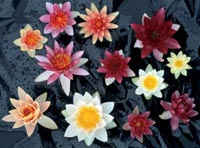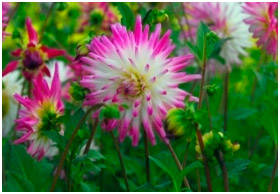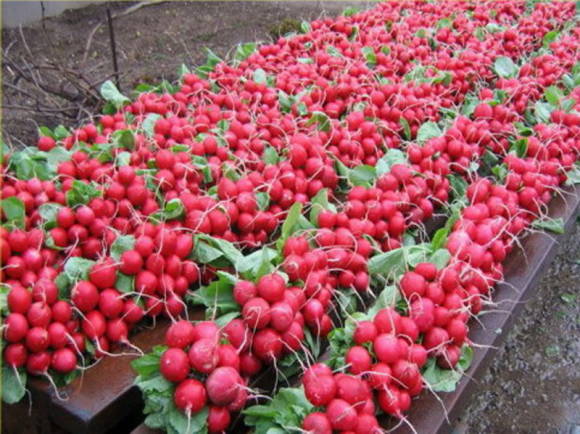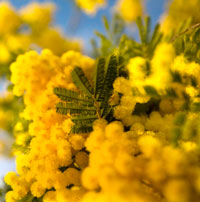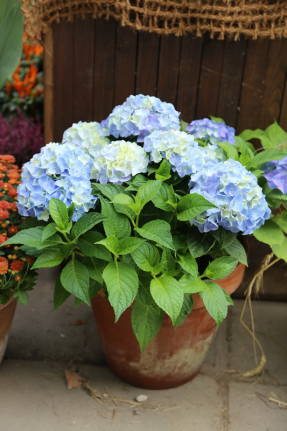
Large-leaved hydrangea, or garden (Hydrangea macrophylla) - one of the most decorative species of flowering plants. Its season begins in early spring, usually by March 8, flower shops begin to delight us with compact shrubs with huge caps of inflorescences of various shades in white, blue, purple and pink, but the peak of sales falls on Easter, when this plant is bought for temporary decoration, and discard after flowering. Trying to preserve the hydrangea at home, flower growers face big problems in caring for it, the plant quickly withers and often dies.
Hydrangea is actually not a houseplant, it is a perennial shrub for open ground, although it requires careful shelter in our area (cm. Large-leaved hydrangea). She needs a mandatory winter rest, hydrangeas for flowering and further survival need to be spent about 3-4 months in cold conditions at temperatures close to zero. This is what is an obstacle for most gardeners who want to keep their hydrangeas indoors all year round.
Care after purchase in the spring
Lighting... Place the hydrangea in a bright spot where it gets at least 6 hours of sunlight. South windows are best suited. Provide the plant with good ventilation so that overheating does not occur through the glass.
Temperature... Hydrangea needs cool conditions. It is optimal to maintain + 16… + 18оС in the room. In hotter conditions, flowering will end quickly, leaves may begin to turn yellow and fall off.
Watering. It is important to keep the soil evenly moist. After the top layer has dried by 1-2 cm, pour abundantly until the water comes out into the sump. Do not allow the earthen clod to dry out and do not leave excess water in the pan for a long time, they must be drained 15-30 minutes after watering. Daily watering may be required. When the water in the pot stagnates, the roots will start to rot and the plant will quickly die.

Further care
Once the danger of recurrent frost is over, move your potted hydrangea outdoors, in your garden, or on your balcony.
In the garden. If winter temperatures in your area do not drop below -23 ° C (USDA Zone 6), you can plant your hydrangea permanently in your garden. But even in a more severe climate, in the 5th zone of winter hardiness (up to -29 ° C), you can try to plant it in open ground. Find a quiet, wind-protected place for her, preferably in the morning sun (but there should be at least 6 hours of sunshine a day). The plant itself tolerates rather severe frosts, the aboveground part of it dies, and in the spring new shoots grow from the ground, but such bushes do not bloom. Unlike other outdoor hydrangeas, this species lays flower buds on the tops of last year's shoots, which just freeze out.
The exception is some new varieties that bloom on both last year's shoots and new ones. But such varieties should be sought in nurseries, not in flower shops. In order for flowering to occur, it is necessary to protect the aboveground part of the hydrangea from frost, carefully cover it in layers in the fall, bending all the shoots to the ground, or carefully dig it out of loose peat soil and place the bush in the cellar, protecting the roots from completely drying out, and in the spring, plant the hydrangea again in the garden, protecting shoots from recurrent frosts. It needs an evenly moist but well-drained acidic soil (pH 5.5 to 6.2).
In a container. it The most reliable way to grow large-leaved hydrangea is when the plant spends time in the garden from spring to late autumn, and for the winter it is transferred to a cool greenhouse or cellar, preventing the soil from drying out completely.
Lighting. In the northern regions, it is better to place the container with hydrangea in the sun, and in the southern regions, in a light shade.
Soil and transplant. When you buy a blooming hydrangea, you are buying a plant that is obviously more than a year old. The root system of such a bush is usually well developed and tightly braids the entire volume of the soil. The plant dries quickly, so it is helpful to carefully transfer the hydrangea into a larger pot before taking it out into the garden. The soil must be selected acidic (pH 5.5-6.2). A high-moor peat-based substrate, brought to the desired acidity, is suitable. To ensure good drainage, mix it with perlite in a 3: 1 ratio.
Read more in the article Transplanting indoor plants.
The acidity of the soil (pH) has a curious effect on the color of the hydrangea, it can be blue or pink. The acidity of the soil does not affect the white color. In a neutral substrate (pH 7.0), the flowers will become deep pink. In acidic soil (pH 5), they turn blue. A purchased pink hydrangea may bloom in lilac or blue the next year, and vice versa. But try to avoid alkalization of the soil when the pH value exceeds 7.0. In alkaline soil, the foliage will turn yellow, growth will slow down sharply, the hydrangea may die.
 |  |
Watering from spring to autumn, before the beginning of leaf fall, regular and abundant, with soft water, preventing stagnation of water in the pot, hydrangea does not tolerate this. After the end of flowering, the need for water becomes less, but on hot summer days it is sometimes necessary to water several times a day. To maintain the acidity of the soil, add lemon or other citrus juice to the water, this is the safest way to acidify the soil in a container plant. With the onset of leaf fall, watering is reduced, and in winter, when kept cold, water is rarely watered, but not until the soil is completely dry.
Air humidity for hydrangea need medium (40-60%). Dry air can cause wilting and damage to leaves and flowers.
Fertilizers. Do not fertilize while the hydrangea is in bloom. After flowering, from April to September, feed every 2 weeks only with complex fertilizers with microelements, for example, NPK 10-10-10 in a half dosage. You cannot feed with homemade fertilizers, for example, ash, which will cause alkalization of the soil.
Pruning. When the buds are withered, remove them. Due to their compact growth, hydrangeas require a little pruning. To control growth and size, you can shorten last year's long stems as soon as they finish flowering. Do not cut the shoots of the current season, flower buds are laid in their upper part for future flowering in spring. With age, a thick bush must be thinned out, some old branches removed.
Autumn - winter - spring. In the fall, do not rush to bring the hydrangea into the house. Protect the plant from light frost by covering it up or moving it temporarily to greenhouses so it can stay in the garden for a few weeks longer. After the leaves fall off, but until the soil in the container freezes, place the plant in a cold (0 ... + 5 ° C) dark place, it can be in the basement or garage. Maintain the soil in a slightly damp state so that the roots do not dry out. After 3-4 months of cold rest, in mid to late January, transfer the plant to a cool (+ 10 ° C) and bright place where the plant will receive bright light, but not direct sun. After 2-3 weeks, move to the sun and raise the temperature to + 15 ... + 18 ° C, start normal watering. New leaves will appear soon, and then bloom will come. Hydrangea prefers cool conditions. Before taking it out to the garden, keep the container with the plant in a greenhouse or on an insulated balcony.

Reproduction. The variety you like can be propagated vegetatively by rooting cuttings. In spring or summer, cut a branch of about 10 cm from a new growth and root it according to the standard method, in a greenhouse using root formation simulators (Kornevin, etc.) in a wet substrate (perlite, a mixture of perlite and peat, peat or coconut tablets).
Read more in the article Cutting indoor plants at home.
Pests. Large-leaved hydrangea can be affected by aphids, mealybugs, ticks. Before taking the container outside, treat it with the systemic preparations Aktara or Confidor for prophylactic purposes, they will give long-term protection against many insects. If pests are found, also treat with appropriate preparations, for insects - with insecticides, against ticks - with acaricides.
About plant protection - in the article Houseplant pests and control measures.
Possible growing problems
- Hydrangea suddenly fades... This could be caused by a lack of water or too high a temperature. Soak the clod and move the plant to cooler conditions.
- Yellow leaves... Yellowing of old leaves often occurs from waterlogging. If the young leaves are yellow, it could be caused by too hard watering. Normalize watering regime and use only soft water.
- Brown dry leaves... The reason is hot dry air. Increase the humidity and move the plant to cooler conditions.
- The inflorescences have changed color... This is due to a change in the acidity of the soil. In a shift in acidity to a neutral value, the flowers turn pink, and when the soil is acidified, they turn blue.
- Brown spots on the leaves can be caused by gray mold (Botrytis). The disease is facilitated by the long presence of water on the leaves of the plant. Remove diseased leaves, treat with fungicide, improve indoor ventilation.
- Large black areas on leaves... The plant has been exposed to frost or leaf spray. Hydrangea does not tolerate severe frosts, do not expose it to negative temperatures, do not use leaf varnishes.
- Matte white or gray-white bloom on leaves is caused by a fungal disease - powdery mildew. Plants oppressed by poor conditions are most susceptible to it. Remove heavily affected leaves, treat with a fungicide (Skor, Topaz, etc.), change the conditions of detention.



